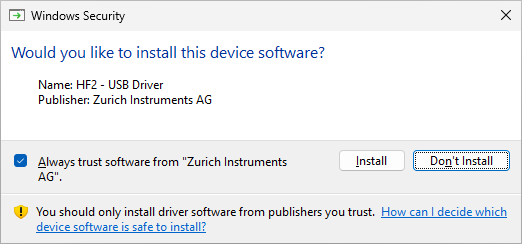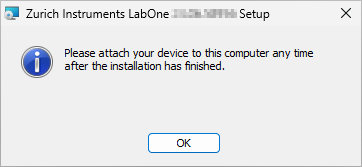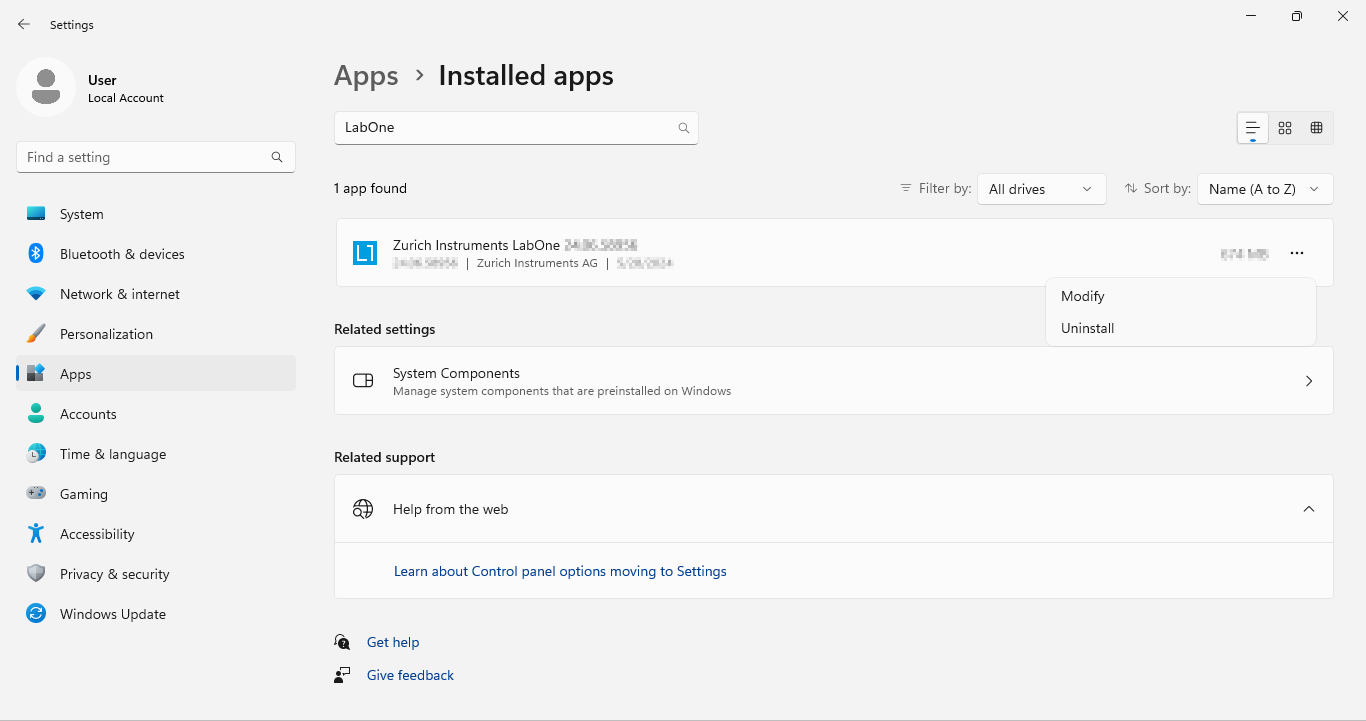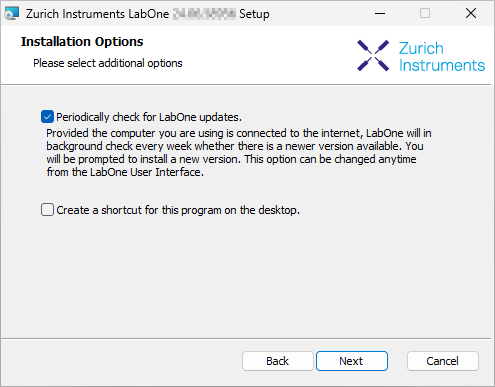Running LabOne on a Separate PC¶
By default the LabOne Web Server and the Data Server run on the embedded computer in the instrument. It can be advantageous to run both servers on a separate PC, especially when using high data transfer rates or recording high-resolution FFT spectra. The higher processing power of laptop and desktop computers improves UI responsiveness, allows for a higher number of frequency points in the Spectrum Analyzer tool, and reduces the probability of data loss.
To run the Data Server on a separate PC, the LabOne software must be installed on that PC. See Software Installation for LabOne installation instructions. Software Architecture gives an overview of the LabOne software architecture that is particularly useful when using multi-instrument control or the programming interfaces.

Software Installation¶
The MFLI Instrument comes with the LabOne software pre-installed and is ready to work out of the box. The LabOne software can also be installed on Windows and Linux PCs. This can be advantageous for performance reasons, and is necessary to use the MATLAB, LabVIEW or Python APIs with the instrument. To install the LabOne software on a computer, administrator rights may be required. In order to simply run the software later, a regular user account is sufficient. Instructions for downloading the correct version of the software packages from the Zurich Instruments website are described below in the platform-dependent sections. It is recommended to regularly update to the latest software version provided by Zurich Instruments. Thanks to the Automatic Update check feature, the update can be initiated with a single click from within the user interface, as shown in Software Update.
Installing LabOne on Windows¶
This section describes how to additionally install the LabOne Software on Windows. This is only necessary if you wish to access the User Interface with a Web Server running on a PC instead of on the MFLI, itself, to use one of the LabOne APIs, or for multi-device synchronization. The installation packages for the Zurich Instruments LabOne software are available as Windows installer .msi packages. The software is available on the Zurich Instruments Download Center. Please ensure that you have administrator rights for the PC on which the software is to be installed. See LabOne compatibility for a comprehensive list of supported Windows systems.
Windows LabOne Installation¶
-
The MFLI Instrument should not be connected to your computer during the LabOne software installation process.
-
Start the LabOne installer program with a name of the form
LabOne64-XX.XX.XXXXX.msiby a double click and follow the instructions. Windows Administrator rights are required for installation. The installation proceeds as follows:-
On the welcome screen click the Next button.

Figure 2: Installation welcome screen -
After reading through the Zurich Instruments license agreement, check the "I accept the terms in the License Agreement" check box and click the Next button.
-
Review the features you want to have installed. For the MFLI Instrument the "MF Series Device", "LabOne User Interface" and "LabOne APIs" features are required. Please install the features for other device classes as well, if required. To proceed click the Next button.

Figure 3: Custom setup screen -
Select whether the software should periodically check for updates. Note, the software will still not update automatically. This setting can later be changed in the user interface. If you would like to install shortcuts on your desktop area, select "Create a shortcut for this program on the desktop". To proceed click the Next button.
-
Click the Install button to start the installation process.
-
Windows may ask up to two times to reboot the computer if you are upgrading. Make sure you have no unsaved work on your computer.

Figure 4: Installation reboot request -
During the first installation of LabOne, it is required to confirm the installation of some drivers from the trusted publisher Zurich Instruments. Click on Install.

Figure 5: Installation driver acceptance -
Click OK on the following notification dialog.

Figure 6: Installation completion screen
-
-
Click Finish to close the Zurich Instruments LabOne installer.
-
You can now start the LabOne User Interface as described in LabOne Software Start-up and choose an instrument to connect to via the Device Connection dialog shown in Device Connection dialog.
Warning
Do not install drivers from another source other than Zurich Instruments.
Start LabOne Manually on the Command Line¶
After installing the LabOne software, the Web Server and Data Server can be started manually using the command-line. The more common way to start LabOne under Windows is described in LabOne Software Start-up. The advantage of using the command line is being able to observe and change the behavior of the Web and Data Servers. To start the Servers manually, open a command-line terminal (Command Prompt, PowerShell (Windows) or Bash (Linux)). For Windows, the current working directory needs to be the installation directory of the Web Server and Data Server. They are installed in the Program Files folder (usually: C:\Program Files) under \Zurich Instruments\LabOne in the WebServer and DataServer folders, respectively. The Web Server and Data Server ( ziDataServer ) are started by running the respective executable in each folder. Please be aware that only one instance of the Web Server can run at a time per computer. The behavior of the Servers can be changed by providing command line arguments. For a detailed list of all arguments see the command line help text:
$ ziWebServer --help
For the Data Server:
$ ziDataServer --help
One useful application of running the Webserver manually from a terminal window is to change the data directory from its default path in the user home directory. The data directory is a folder in which the LabOne Webserver saves all the measured data in the format specified by the user. Before running the Webserver from the terminal, the user needs to ensure there is no other instance of Webserver running in the background. This can be checked using the Tray Icon as shown below.
The corresponding command line argument to specify the data path is
--data-path and the command to start the LabOne Webserver with a
non-default directory path, e.g., C:\data is
C:\Program Files\Zurich Instruments\LabOne\WebServer> ziWebServer --data-path "C:\data"
Windows LabOne Uninstallation¶
To uninstall the LabOne software package from a Windows computer, one can open the "Apps & features" page from the Windows start menu and search for LabOne. By selecting the LabOne item in the list of apps, the user has the option to "Uninstall" or "Modify" the software package as shown in Figure 7.

Warning
Although it is possible to install a new version of LabOne on a currently-installed version, it is highly recommended to first uninstall the older version of LabOne from the computer and then, install the new version. Otherwise, if the installation process fails, the current installation is damaged and cannot be uninstalled directly. The user will need to first repair the installation and then, uninstall it.
In case a current installation of LabOne is corrupted, one can simply repair it by selecting the option "Modify" in Figure 7. This will open the LabOne installation wizard with the option "Repair" as shown in Figure 8.

After finishing the repair process, the normal uninstallation process described above can be triggered to uninstall LabOne.
Installing LabOne on macOS¶
This section describes how to additionally install the LabOne Software on macOS. This is only necessary if you wish to run the Web Server on a computer rather than on the MFLI itself.
LabOne supports both Intel and ARM (M-series) architectures within a single universal disk image (DMG) file available in our Download Center.
- Download and double-click the DMG file to mount the image.
 - The image contains a single LabOne application with all services
needed.
- Once the application is started, a labone icon will appear in the menu
bar. It allows the user to easily open a new session and shows the
status of all services.
- The image contains a single LabOne application with all services
needed.
- Once the application is started, a labone icon will appear in the menu
bar. It allows the user to easily open a new session and shows the
status of all services.
Uninstalling LabOne on macOS¶
To uninstall LabOne on macOS, simply drag the LabOne application to the trash bin.
Application Content¶
The LabOne application contains all resources available for macOS. This includes:
- The binaries for the Web Server and Data Servers.
- The binaries for the C, MATLAB, and LabVIEW APIs.
- An offline version of the user manuals.
- The latest firmware images for all instruments.
To access this content, right-click on the LabOne application and select "Show Package Contents". Then, go into Contents/Resources.
Note
Since the application name contains a space, one needs to escape it when
using the command line to access the contents:
cd /Applications/LabOne\ 2X.XX.app/Contents/Resources
Start LabOne Manually on the Command Line¶
To start the LabOne services like the data server and web server manually, one can use the command line.
The data server binary is called ziDataServer (ziServer for HF2
instruments) and is located at
Applications/LabOne\ 2X.XX.app/Contents/Resources/DataServer/.
The web server binary is called ziWebServer and is located at
Applications/LabOne\ 2X.XX.app/Contents/Resources/WebServer/.
Note
No special command line arguments are needed to start the LabOne
services. Use the --help argument to see all available options.
Installing LabOne on Linux¶
This section describes how to additionally install the LabOne Software on Linux. This is only necessary if you wish to run the Web Server on a computer rather than on the MFLI itself.
Requirements¶
Ensure that the following requirements are fulfilled before trying to install the LabOne software package:
-
LabOne software supports typical modern GNU/Linux distributions (Ubuntu 14.04+, CentOS 7+, Debian 8+). The minimum requirements are glibc 2.17+ and kernel 3.10+.
-
You have administrator rights for the system.
-
The correct version of the LabOne installation package for your operating system and platform have been downloaded from the Zurich Instruments Download Center:
LabOneLinux<arch>-<release>.<revision>.tar.gz,
Please ensure you download the correct architecture (x86-64 or arm64) of
the LabOne installer. The uname command can be used in order to
determine which architecture you are using, by running:
uname -m
in a command line terminal. If the command outputs x86_64 the x86-64
version of the LabOne package is required, if it displays aarch64 the
ARM64 version is required.
Linux LabOne Installation¶
Proceed with the installation in a command line shell as follows:
-
Extract the LabOne tarball in a temporary directory:
tar xzvf LabOneLinux<arch>-<release>-<revision>.tar.gz -
Navigate into the extracted directory.
cd LabOneLinux<arch>-<release>-<revision> -
Run the install script with administrator rights and proceed through the guided installation, using the default installation path if possible:
sudo bash install.shThe install script lets you choose between the following three modes: - Type "a" to install the Data Server program, the Web Server program, documentation and APIs. - Type "u" to install
udevsupport (only necessary if HF2 Instruments will be used with this LabOne installation and not relevant for other instrument classes). - Type "ENTER" to install both options "a" and "u". -
Test your installation by running the software as described in the next section.
Running the Software on Linux¶
The following steps describe how to start the LabOne software in order to access and use your instrument in the User Interface.
-
Start the LabOne Data Server program at a command prompt:
$ ziDataServerYou should be able to access your instrument. In case of problems please consult the Troubleshooting at the end of this chapter.
-
Start the Web Server program at a command prompt:
$ ziWebServer -
Start an up-to-date web browser and enter the
127.0.0.1:8006in the browser’s address bar to access the Web Server program and start the LabOne User Interface. The LabOne Web Server installed on the PC listens by default on port number 8006 instead of 80 to minimize the probability of conflicts. -
You can now start the LabOne User Interface as described in LabOne Software Start-up and choose an instrument to connect to via the Device Connection dialog shown in Device Connection dialog.
Warning
Do not use two Data Server instances running in parallel; only one instance may run at a time.
Uninstalling LabOne on Linux¶
The LabOne software package copies an uninstall script to the base
installation path (the default installation directory is /opt/zi/). To
uninstall the LabOne package please perform the following steps in a
command line shell:
-
Navigate to the path where LabOne is installed, for example, if LabOne is installed in the default installation path:
$ cd /opt/zi/ -
Run the uninstall script with administrator rights and proceed through the guided steps:
$ sudo bash uninstall_LabOne<arch>-<release>-<revision>.sh
LabOne Software Architecture¶
The Zurich Instruments LabOne software gives quick and easy access to the instrument. LabOne also supports advanced configurations with simultaneous access by multiple software clients (i.e., LabOne User Interface clients and/or API clients), and even simultaneous access by several users working on different computers. Here we give a brief overview of the architecture of the LabOne software. The information in this section is presented for the case when LabOne is run on a separate PC rather than on the embedded computer on the MFLI Instrument.
The software of Zurich Instruments equipment is server-based. The servers and other software components are organized in layers as shown in Figure 9.
- The lowest layer running on the PC is the LabOne Data Server, which is the interface to the connected instrument.
- The middle layer contains the LabOne Web Server, which is the server for the browser-based LabOne User Interface.
- The graphical user interface, together with the programming user interfaces, are contained in the top layer.
The architecture with one central Data Server allows multiple clients to access a device with synchronized settings. The following sections explain the different layers and their functionality in more detail.

LabOne Data Server¶
The LabOne Data Server program is a dedicated server that is in charge of all communication to and from the device. The Data Server can control a single or also multiple instruments. It will distribute the measurement data from the instrument to all the clients that subscribe to it. It also ensures that settings changed by one client are communicated to other clients. The device settings are therefore synchronized on all clients. The Data Server is started automatically by a service when the PC is started. This service can be disabled if necessary, though the Data Server consumes only little resources when there is no active session. On a PC, only a single instance of a LabOne Data Server should be running.
LabOne Web Server¶
The LabOne Web Server is an application dedicated to serving up the web pages that constitute the LabOne user interface. The user interface can be opened with any device with a web browser. Since it is touch enabled, it is possible to work with the LabOne User Interface on a mobile device - like a tablet. The LabOne Web Server supports multiple clients simultaneously. This means that more than one session can be used to view data and to manipulate the instrument. A session could be running in a browser on the PC on which the LabOne software is installed. It could equally well be running in a browser on a remote machine.
With a LabOne Web Server running and accessing an instrument, a new session can be opened by typing in a network address and port number in a browser address bar. In case LabOne is run on the embedded computer of the Instrument, please refer to Connecting to the MFLI Instrument to learn what address to use to access the Web Server. In case the Web Server runs on the same computer as the browser, the address is the localhost address (both are equivalent):
127.0.0.1:8006(only valid when LabOne is running on a separate PC)localhost:8006(only valid when LabOne is running on a separate PC)
In case the Web Server runs on a remote computer, the address is the IP address or network name of the remote computer:
192.168.x.y:8006myPC.company.com:8006
Note that the latter is technically equivalent to the case when the Web Server runs on the embedded computer on the Instrument. In that case the IP address of the Instrument is used. The most recent versions of the most popular browsers are supported: Chrome, Firefox, Edge, Safari and Opera.
LabOne API Layer¶
The instrument can also be controlled via the application program interfaces (APIs) provided by Zurich Instruments. APIs are provided in the form of DLLs for the following programming environments:
- MATLAB
- Python
- LabVIEW
- .NET
- C
The instrument can therefore be controlled by an external program, and the resulting data can be processed there. The device can be concurrently accessed via one or more of the APIs and via the user interface. This enables easy integration into larger laboratory setups. See the LabOne Programming Manual for further information. Using the APIs, the user has access to the same functionality that is available in the LabOne User Interface.

